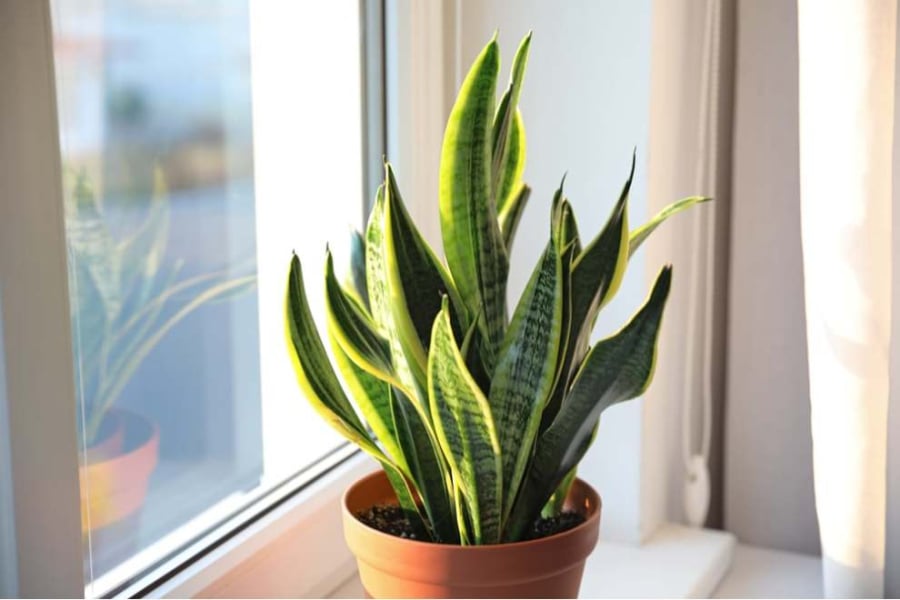What is a Snake Plant?
A snake plant is a type of ornamental plant that is often grown in gardens or indoors to enhance the aesthetic of the space. Its scientific name is Sansevieria trifasciata, and it usually grows to a height of 50-60cm.
The snake plant has a flat, succulent stem that may appear sharp and dangerous, but it is actually soft and does not cause harm when touched. The stem has two colors, green and yellow, running vertically from the base to the tip. When the snake plant blooms, it forms clusters of round-shaped flowers that grow from the base.
Snake plants have their origins in tropical regions and there are more than 70 different species, such as tiger snake plant, Thai snake plant, and green snake plant. However, the most common ones nowadays are Thai snake plant and tiger snake plant.

Feng Shui Meaning of Snake Plants
In both Western and Eastern cultures, snake plants are believed to have the power to ward off evil spirits, counteract negative energy, and bring luck and prosperity to the owners. Snake plants are also considered meaningful gifts to wish good luck to friends and family, success with business partners, and wealth in the new year or new homes.
According to Feng Shui principles, snake plants can also repel demons and ghosts. The leaves of the snake plant resemble sharp knives and are considered the power of the mountain god, capable of expelling negative energy and minimizing misfortunes for the family.
That’s why people often see rows of snake plants planted as barriers in front of houses or in front of buildings.

Snake Plants Prefer These 3 Types of Water:
Soybean Water
Method:
- Put soybeans in a pot, add water, and bring it to a boil.
- After it cools down, pour out the water and soybeans into a plastic bucket, tightly seal the lid and wait for fermentation. Generally, it can be fermented for about 2 months.
Frequency of use:
Water the snake plant once every half a month.
Soybean water provides sufficient nutrients for leafy plants like snake plants and stimulates new shoots to grow rapidly after being watered.
Willow Water
Method:
- Pick fresh willow branches, cut them into small pieces with scissors, and put them in a plastic bottle.
- Add water to the plastic bottle, soak for 2-3 days, and then use.
The rich salicylic acid in willow branches can promote the growth of the snake plant. If you use willow water to water the snake plant multiple times, the snake plant will naturally continue to grow, and new leaves will appear regularly.
It is ideal for snake plants that haven’t grown new leaves for a long time.
Beer Water
Method:
- Pour beer into a container and let it sit for a few days to evaporate the alcohol.
- Then add 20 parts water to dilute it.
Using this beer water to clean the leaves of the snake plant not only removes dust but also enhances the photosynthesis ability of the leaves, making them brighter and shinier.

Some Notes on Planting and Caring for Snake Plants:
If you follow the principles below correctly, you will have a perfect pot of snake plants.
Watering: Snake plants have originated from dry regions and have excellent drought tolerance. Therefore, they do not require much water. During the care process, you should not overwater the plants. On the contrary, the plants only need to be watered once every 1 or 2 weeks, depending on the weather conditions. When watering the plants, it is recommended to use a watering can to spray the plants with moisture.
Light: Snake plants prefer shade rather than direct sunlight. It is best to choose areas with low light to plant the snake plants. If the plants are placed indoors, they should be exposed to sunlight after 2-3 months, with a duration of around 7-9 am.
Temperature and Nutrition: The ideal temperature for the plants to grow is around 20-30 degrees. In winter days, you should supplement the plants with nutrients by fertilizing them to keep them healthy and thriving. Fertilizers should be applied every 3 to 4 months, with a position about 10cm away from the base.
2023 Lunar New Year Gift Ideas for Older Family and Friends
As 2021 approaches, families worldwide are gathering to celebrate the special bond between grandparents and their grandchildren. To show their love and admiration, these thoughtfully chosen gifts will bring a smile to the face of the elderly. Here, we have compiled a list of the 13 most meaningful Tet presents that can bring joy to our beloved grandparents.






































